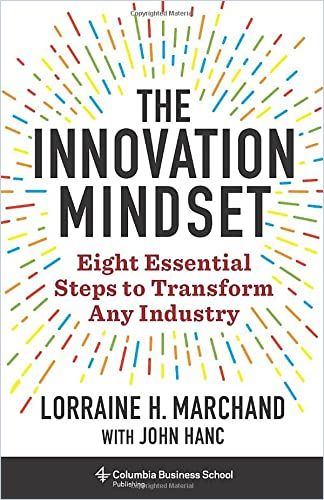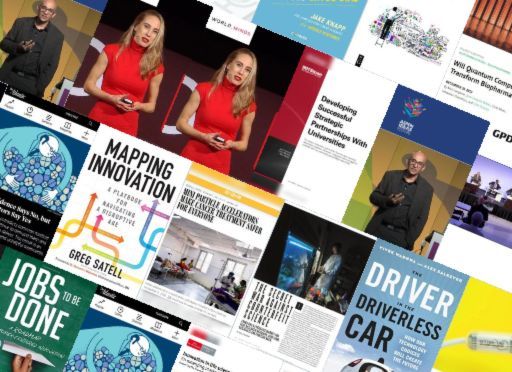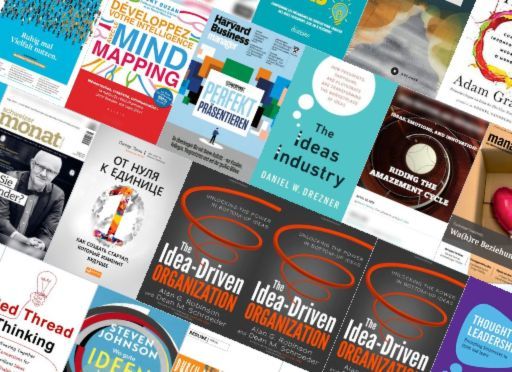“Make Sure There Is A Customer”

In The Innovation Mindset, author Lorraine Marchand recommends brainstorming and iteration methods based on her years of product development experience and insight. Success begins when product developers design with their customers firmly in mind.
In your book, The Innovation Mindset, you emphasize coming to the right problem and illustrate many examples of “solutions without a problem.” Why is making sure you’ve defined the right problem more important than coming up with killer ideas?
Lorraine Marchand: In my career assisting entrepreneurs and innovators, I would say in about 95% of the situations where I’m asked to coach or mentor, whether for a big company or a student startup, they have a really great idea, but we actually don’t know what problem we’re solving. They don’t actually have a product or service that the commercial marketplace is interested in paying for. So, there’s a practical aspect of avoiding that kind of disappointment. It’s very fundamental to the innovation process and the commercialization process to start with the problem that a customer is willing to have us solve.

So, identifying the correct customer becomes very important to define what the problem is.
Yes. The problem-solving methodology is all around observation: observing the problem in its natural habitat, having some kind of proof points that it’s recurring, being able to talk to the customer or the end user. The customer isn’t always the person that’s experiencing the issue or problem, but certainly, you need to do your research around the problem and who’s experiencing it in order to validate and further describe it.
What processes can people use to ask better questions?
I talk about the “six killer questions,” and number one, which you just raised, is, do you know who your customer is? A lot of times, people get tripped up over that because you can have an intermediary, you can have a decision-maker, you can have somebody who’s experiencing the problem but have a different person who’s willing to pay for the solution. In my field of healthcare, a lot of times, we’re trying to discern: is the customer the patient, the physician, the regulator? And a lot of times maybe it’s all of the above. But we need to do the research and the customer map in order to discern the needs and the values of each of those groups.
You list several techniques in your book, but what is your favorite go-to process to brainstorm and shift your mindset when looking at a problem?
My favorite one is called “first principles,” and it’s a deconstruction methodology that Elon Musk used when he was first challenged with how to bring the price of the electric car battery down. When electric cars first came to market, the price was exorbitant – $90- or $100,000. After some research, Musk realized about 60% of that cost was in the battery. He was told there was no way to bring that cost down. But he deconstructed the battery. He looked at all the elements and components and determined that 60 to 70% of the battery’s operating power was coming from the cobalt, which also represented about 60% of the battery’s cost.
As Musk deconstructed that battery, he realized that if he could replace the cobalt, that would be the secret to bringing down the price of the battery. So he went with lithium and then nickel – much less expensive than cobalt.
It worked extremely well, and he was able to bring that car battery down from $60,000 to $25,000 by tackling the problem of where is the cost in the battery? Where is the value in the battery? Let me take it down to its basic elements and then do a piece-part analysis and then rebuild it.
That’s a vivid example of a powerful process. You emphasize Minimal Viable Products (MVPs) in your book. What are the essential features and benefits of an MVP?
No matter what kind of innovation you’re practicing, whether it’s failing fast or whatever your constraints are, I think that a minimal, viable product is still an essential element. It means you’re going to test the benefits, the functionality of your solution with an audience that you believe is willing to pay for it, just to make sure there is a customer.
What’s a good example?
When Nick Swinmurn, the founder of Zappos, got started, all he wanted to prove was one thing: that people were willing to buy shoes online. So he looked at a certain kind of low-profile hiking boot that was difficult to come across in the LA area. He knew other people who were interested in it. He put together a flyer he distributed to people’s mailboxes, and all he said was, “Are you interested in this boot? If so, please click on this website and leave your information.” He got a lot of hits from that. And then he actually went around the greater LA area buying up these boots physically, then delivering them to people’s houses and completing the transaction.
I love that example because he wasn’t trying to figure out will people transact with their credit card online or how many boots will they buy. All he wanted to know is will people buy shoes online?
He proved they would. And, as you know, Zappos became famously successful and was sold some number of years ago for a great multiple, and online shoe purchasing is a staple of how we shop these days.
So, the idea of testing just one thing at a time, getting a product into a customer’s hands and getting that feedback as soon as possible, that’s the MVP goal. In your book, you talk about several types of testing methods. Is there a type of testing you might recommend more often to younger innovators without much capital?
You can do a lot with a screenshot, a simulation of your product or your app, or your software, and just a guided discussion guide. In the world of drug development, we use something called a “target product profile.” In there, we describe the drug, who it’s for, what benefits you’re going to get, what we think the price points are, what any adverse effects are. Then we go out and talk to hundreds and hundreds of doctors in order to determine whether the attributes of this drug and the way it’s going to function in the patient is attractive to them. Is it something they’re interested in offering to patients?
You can do a lot with simulation and good questions.
How is thinking in terms of developing an MVP changing organizational thinking about innovation in practical terms?
I absolutely believe that corporations need to be more tuned into this idea of an MVP or whatever terminology they want to use. I can tell you, having sat in meetings at very large companies, including IBM, I was always surprised that a lot of times engineers would spin up new products with the help of, possibly, one reference customer, and then bring it to the general manager of the Life Sciences – this is the role I had at the time – and then say to me, “We want you to productize this. Take it out to all the pharma customers. We’re sure they’re going to love it.” And the fact of the matter is, one reference customer for whom you’ve designed a service or solution without really testing it more broadly through an MVP, going through all the steps, is a non-starter. I’d have to push back and insist we go through the MVP steps because I’m not convinced we have a customer who is interested in this particular product. That idea of testing minimal functionality and a minimal number of features to make sure you’ve got a target audience is fundamental to good, commercialization.
That perfectly leads to my next question: What is the Law of 100 Customers? And how might it feed into an ability to pivot at any stage during innovation?
I have found that whether it’s a Fortune 50 company like IBM trying to test a new solution they want to take to pharma, or whether it’s a startup student at Columbia, whether they have big budgets or not, the hardest thing for them to do is talk to customers. It’s just a really hard thing for people to do. So I insist that, particularly in those early stages, you have to talk to 100 customers. There’s statistical relevance in being able to talk to 100. You can cut the data in different ways and you’ve got something meaningful you can build the rest of your research on.
There’s a method to doing the customer research. It all builds and reinforces and allows you to learn as you go.
There’s also the power of being able to iterate, to pivot, to learn new information when you talk to 100. We’ve got to get those questions to 100 customers before we know we’ve passed the feasibility test and go to the next stage of the process, which builds off those answers. And you’re absolutely right; you have got to pivot if information comes in from the marketplace or from the customer indicating that some aspect of your solution or service needs to be modified. I’m a big believer in the pivot.
What are some top-line ways that companies can apply some of your principles for developing “intrapreneurship,” in-house innovation?
I love that question because I’ve been doing additional work since The Innovation Mindset was published and have come up with what I call the “Five C’s” of corporate innovation: Chance, Collaboration, Customer, Culture and Change. If a company supports taking chances, we convey that into risk.
Risk can be strategic. We can invest in risk in a way that helps to grow our portfolio in a disciplined and constructive manner, and we can also manage and mitigate the downside of risk.
Then there’s encouraging collaboration. There’s evidence to show that when you integrate business units – support services and functions in a company – the ability to drive revenue grows exponentially. So, you start with a company that goes to market with just one service line. What happens when other service lines are added in? Now we’re expanding our solution. We’re upselling. We’re learning so much more about the customer. All of that benefits growth. So, encouraging true collaboration within companies so that everybody is aligned around the strategic objectives and they’re goal-oriented. They come out of their silos. If the customer is our unifying principle within the corporation, then we are going to do the proper kind of research. If we use the customer as the True North, that’s going to guide us to have more successful innovations and it’s going to make everyone privy to how the customer is thinking.
Who wants to be in a company where you feel removed from the customer? Business connectivity comes through understanding the customer.
Then, clearly, we’ve got to have the right culture. When I think about a culture of innovation, it’s got to be a safe place to fail. And I use the word “fail” very, very rarely because I prefer the word “pivot.” But it’s really hard to talk about innovation in a corporate setting without bringing up the word fail, because it’s probably one of the biggest reasons why people in corporations have a fear of trying something new. I really loved the mantra of Jeff Bezos at Amazon: Try, Fail, Learn. He incented people to try things that didn’t pan out as much as he incented those who had the ideas that actually went to market. I liked his model so much I started my own stand-up meetings on Fridays with my own team.
I made it “Fail-Safe Friday,” where I talked with the team about the things they were working on that weren’t working out or what were the lessons they learned that week.
And we had some fabulous, instructive, transparent conversations about what was working and what wasn’t working. In order to embrace innovation in a corporate environment, you’ve got to be able to create an environment where people understand and support the change you’re making. There’s got to be this idea of embracing change because you can’t innovate and experiment in a company without also creating an environment where you help people manage and navigate change. So, those are some of the ways you create that safe environment where experimentation is valued and people don’t have to worry about failing.
You note in your book that women hold only 5% of patents and that 95% of women-founded businesses fail in their first year because they can’t find funding. What can women innovators do to ensure their greater success? And what can companies do to be sure that they include women in entrepreneurship opportunities?
I’m really passionate about encouraging more women to try innovation to try creativity. I think it gives them a lot more control over their lives and over their careers. It gives them more choices. It gives them more financial security. I want more women to lean in and try this activity of innovation. As a society, we’ve got to get more women in STEM – science, technology, education and math – programs. It can be difficult for women to pursue STEM careers. Then, when they’re in STEM careers, it can be difficult to stay there for various reasons. Being a scientist in what’s still a very male-dominated industry and profession can be challenging.
So, find ways to support women, to help them create work-life balance, give them opportunities to care for their children and family, give them opportunities to learn and develop.
There are also ways women need to be more effective in their networking. Research shows that women tend to network in ways that feel comfortable. So, for example, in a corporation, maybe it’s going to be with women in their own department or their own function. But you really need a diverse kind of ecosystem for innovation to flourish. And the diversity can certainly be gender, racial, ethnic, but most importantly, you need people with different perspectives and experiences. So, reach out to an attorney who can talk with you about filing patents or the importance of trademark or copyright, or how to set up your entity. Reach out to somebody with more of a regulatory background if your innovation is something that’s going to require regulatory approval. Talk to someone who’s been a chief operations officer and understands operating models and the operational aspects of running a business, or an accountant who can talk with you about the ways of putting your numbers together, or a financial investor. You need to talk with individuals from all these different walks because those are all important functions to get a startup going and to run a business.
If you only talk with people in your content area or in your department or those you feel comfortable with, you’re not going to get the expansiveness of relationships and perspectives that you need.
It’s one of the reasons why women aren’t as comfortable raising capital, which is a very male-dominated industry. The more we have women comfortable raising capital, the more we have women in the seats encouraging other women – We can see this by the numbers. About 2.5% of women entrepreneurs successfully raised cash from VCs. And, interestingly, at the time of the study, that correlates to about 2.5% of VCs had women partners, so, about the same ratio. As those numbers go up, we naturally see that tide raising all boats.
About the Author:
Lorraine Marchand is a strategic growth and business innovation expert and author of The Innovation Mindset. Find out more about her services at LorraineMarchand.com.








